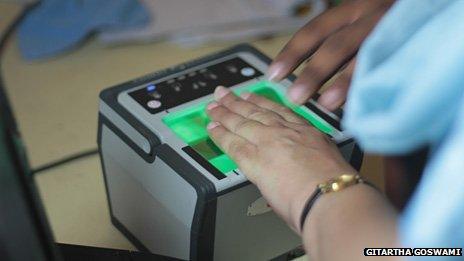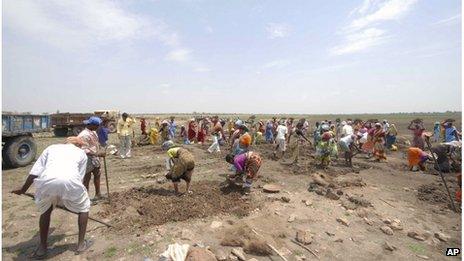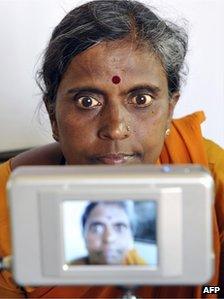Will India's identity number really be a game changer?
- Published

The identity number is aimed at facilitating services for the poor
What does the <itemMeta>news/world-asia-india-18141584</itemMeta> , also called Aadhaar (Foundation), mean for Indian people?
Unlike the usual use of biometric identification for security purposes, Aadhaar is aimed at facilitating services for the country's poor.
Excessive cost and loss of privacy, two common objections to identity schemes all over the world, are not the main topics of debate in India.
It costs the government only 88 rupees ($1.59) to enrol each person. At $263m, last year's budget for the identity scheme was just 2% of India's annual food subsidy.
Authorities have been silent about privacy concerns, although many commentators are sceptical and parliamentary reports warn against the dangers of not having a data protection law.
Limitations
Instead, discussion on the identity number has largely focused on its feasibility and whether it will really help the poor, leavened with occasional technophilic euphoria about eliminating human intermediation.
There had been little advance thinking about the use of Aadhaar, but now that the numbers have begun rolling out, it's generating more informed debate from both sides.
Since income in India is difficult to measure, the welfare system tries to identify below poverty line (BPL) households based on ownership of goods, housing quality, educational attainments, etc.
Many welfare benefits are targeted only to such BPL homes. However, the government's own surveys show that this method excludes many deserving poor, while including many better-off households.
Such faulty identification cannot be rectified by the identity number. The number can track who gets welfare benefits and detect fraud, but cannot ensure that they deserve it.
There are also many who see the identity number as a ruse to convert all welfare benefits to cash transfers.

Payments for the jobs guarantee scheme will be linked to the identity number
Early evidence from field trials indicate that Aadhaar can improve but not replace existing delivery platforms.
There are reports about absent bank agents who are supposed to deliver payments to villagers using Aadhaar for authentication. Then there is the question of poor internet connectivity in villages.
Also, while Aadhaar can help prevent corruption involving impersonation, it is of limited use in collusive situations - when functionaries and villagers conspire to report non-existent work, say, in the multi-billion dollar jobs guarantee scheme, and split the payments received.
There is no evidence yet of political conviction to integrate Aadhaar into areas such as health, education and the public distribution system (PDS) for subsidised food.
This would require restructuring delivery processes to enhance traceability and leveraging traceability to fix responsibility. It would mean spending a largely unused multi-billion dollar fund for telecoms to eliminate problems of rural data connectivity to ensure that more people can use the number.
There are other problems as well.
The quality of data collected is being questioned - the postal department claims it can't deliver Aadhaar numbers since a large number of addresses, taken down during enrolment, are incorrect.
Weak service
The readability of fingerprints of people who do a lot of manual work can degrade easily. The relatively high cost of iris scanners, compared to fingerprint readers, means that many service providers may not use them at all.

There are questions over technological glitches
A study by the Unique Identification Authority of India's (UDAI) shows that, with the usual practice of single finger matching, its biometric protocols are rejecting genuine requests at an unacceptably high rate of 6%, more with some types of biometric readers.
This raises the question of whether oversight is weak and if cost-cutting has led to weak service levels.
Beyond these operational problems, the real challenge for Aadhaar is to progress from a techno-focused scheme for the poor to initiatives for all Indians, like using the number to buy railway tickets.
Aadhaar could change India's information technology industry just as its highway development programme transformed the construction industry.
The imagination needs to go beyond using the number to track fake beneficiaries of welfare schemes and making sure that the jobs guarantee scheme worker or old age pensioner gets her dues faster.
For example, Aadhaar could be used to track down fraudulent real estate transactions: when a home buyer suspects that the seller is not the owner of the house he claims to be, he can have his bank biometrically verify the latter's identity number on the house papers.
If biometrics is to be transformative, it must build on the knowledge that the possibility of verification can foster a much higher level of social trust.
An Aadhaar that underpins this change must also confront privacy.
Biometrics is a master key - linking across any database that uses biometric authentication.
To protect privacy, each such database will need additional locks. Linking databases should need consent from multiple key-holders subject to legislative oversight and judicial redress. Governments must convince people that access will not be abused.
If it can earn this trust, Aadhaar can become the foundation not just for delivering to the poor, but also easing everyday life, and as importantly, disciplining the defrauding rich.
Will India find the political imagination to exploit this opportunity or squander it? Keep watching.
<italic>Partha Mukhopadhyay is an economist and a Senior Research Fellow at the Delhi-based Centre for Policy Research</italic>
- Published28 May 2012
- Published30 May 2012